Economics Assignment 1: Analysis of the Australian Dollar Dynamics
VerifiedAdded on 2020/03/16
|14
|2882
|29
Report
AI Summary
This economics assignment delves into the dynamics of the Australian dollar, examining its value in relation to the US dollar and the trade weight index over a three-year period. The report explores the factors influencing the currency's fluctuations, including the demand and supply dynamics in the foreign exchange market, global commodity prices, and the Reserve Bank of Australia's policies. The assignment further analyzes the impact of the Australian dollar's valuation on business activities, particularly the export of alcoholic beverages to the USA, considering the effects of overvaluation on export revenue. Finally, it addresses strategies the Reserve Bank of Australia could employ to devalue the currency, such as increasing the money supply and manipulating trade levels. The assignment references articles and data from reputable sources like the Reserve Bank of Australia and academic publications to support its analysis.
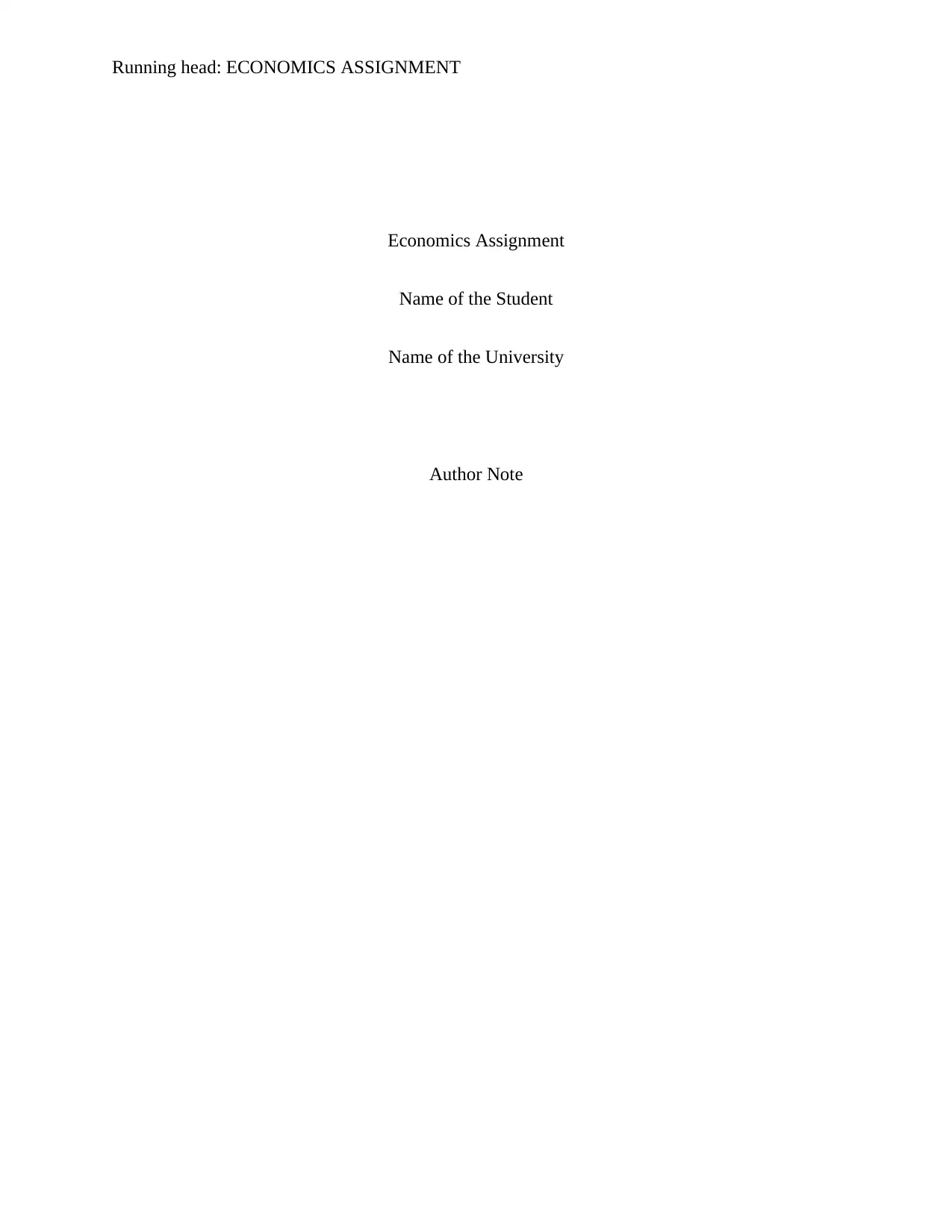
Running head: ECONOMICS ASSIGNMENT
Economics Assignment
Name of the Student
Name of the University
Author Note
Economics Assignment
Name of the Student
Name of the University
Author Note
Paraphrase This Document
Need a fresh take? Get an instant paraphrase of this document with our AI Paraphraser
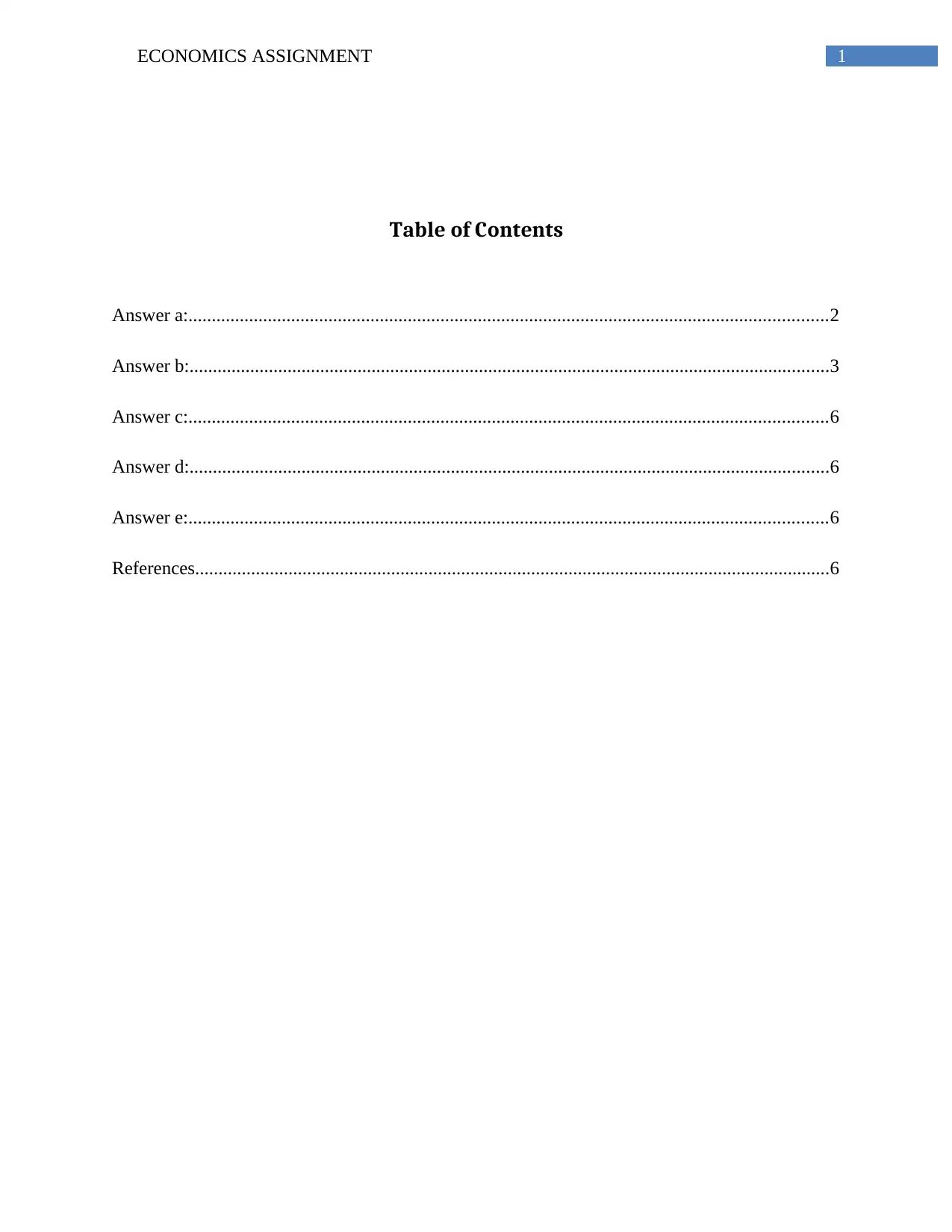
1ECONOMICS ASSIGNMENT
Table of Contents
Answer a:.........................................................................................................................................2
Answer b:.........................................................................................................................................3
Answer c:.........................................................................................................................................6
Answer d:.........................................................................................................................................6
Answer e:.........................................................................................................................................6
References........................................................................................................................................6
Table of Contents
Answer a:.........................................................................................................................................2
Answer b:.........................................................................................................................................3
Answer c:.........................................................................................................................................6
Answer d:.........................................................................................................................................6
Answer e:.........................................................................................................................................6
References........................................................................................................................................6
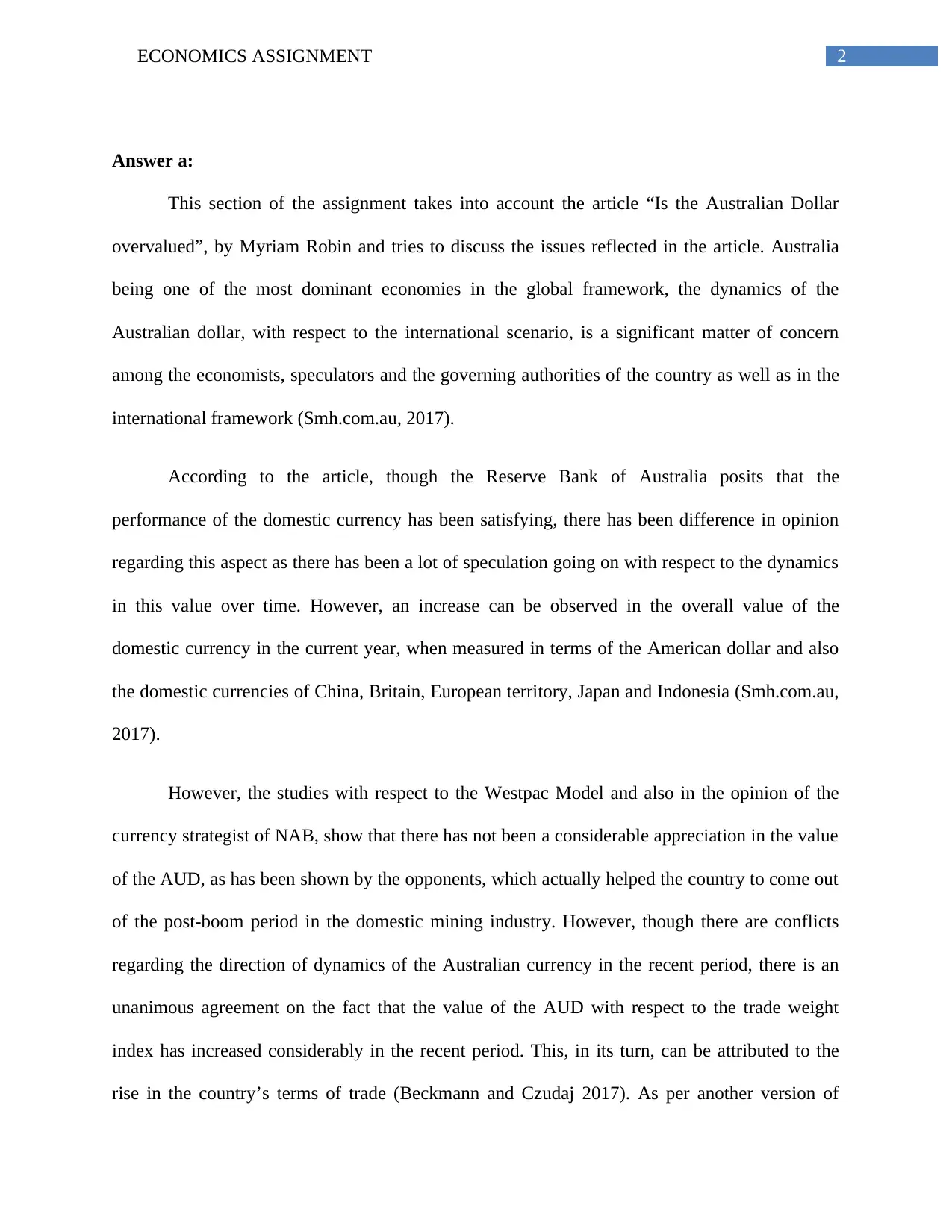
2ECONOMICS ASSIGNMENT
Answer a:
This section of the assignment takes into account the article “Is the Australian Dollar
overvalued”, by Myriam Robin and tries to discuss the issues reflected in the article. Australia
being one of the most dominant economies in the global framework, the dynamics of the
Australian dollar, with respect to the international scenario, is a significant matter of concern
among the economists, speculators and the governing authorities of the country as well as in the
international framework (Smh.com.au, 2017).
According to the article, though the Reserve Bank of Australia posits that the
performance of the domestic currency has been satisfying, there has been difference in opinion
regarding this aspect as there has been a lot of speculation going on with respect to the dynamics
in this value over time. However, an increase can be observed in the overall value of the
domestic currency in the current year, when measured in terms of the American dollar and also
the domestic currencies of China, Britain, European territory, Japan and Indonesia (Smh.com.au,
2017).
However, the studies with respect to the Westpac Model and also in the opinion of the
currency strategist of NAB, show that there has not been a considerable appreciation in the value
of the AUD, as has been shown by the opponents, which actually helped the country to come out
of the post-boom period in the domestic mining industry. However, though there are conflicts
regarding the direction of dynamics of the Australian currency in the recent period, there is an
unanimous agreement on the fact that the value of the AUD with respect to the trade weight
index has increased considerably in the recent period. This, in its turn, can be attributed to the
rise in the country’s terms of trade (Beckmann and Czudaj 2017). As per another version of
Answer a:
This section of the assignment takes into account the article “Is the Australian Dollar
overvalued”, by Myriam Robin and tries to discuss the issues reflected in the article. Australia
being one of the most dominant economies in the global framework, the dynamics of the
Australian dollar, with respect to the international scenario, is a significant matter of concern
among the economists, speculators and the governing authorities of the country as well as in the
international framework (Smh.com.au, 2017).
According to the article, though the Reserve Bank of Australia posits that the
performance of the domestic currency has been satisfying, there has been difference in opinion
regarding this aspect as there has been a lot of speculation going on with respect to the dynamics
in this value over time. However, an increase can be observed in the overall value of the
domestic currency in the current year, when measured in terms of the American dollar and also
the domestic currencies of China, Britain, European territory, Japan and Indonesia (Smh.com.au,
2017).
However, the studies with respect to the Westpac Model and also in the opinion of the
currency strategist of NAB, show that there has not been a considerable appreciation in the value
of the AUD, as has been shown by the opponents, which actually helped the country to come out
of the post-boom period in the domestic mining industry. However, though there are conflicts
regarding the direction of dynamics of the Australian currency in the recent period, there is an
unanimous agreement on the fact that the value of the AUD with respect to the trade weight
index has increased considerably in the recent period. This, in its turn, can be attributed to the
rise in the country’s terms of trade (Beckmann and Czudaj 2017). As per another version of
⊘ This is a preview!⊘
Do you want full access?
Subscribe today to unlock all pages.

Trusted by 1+ million students worldwide
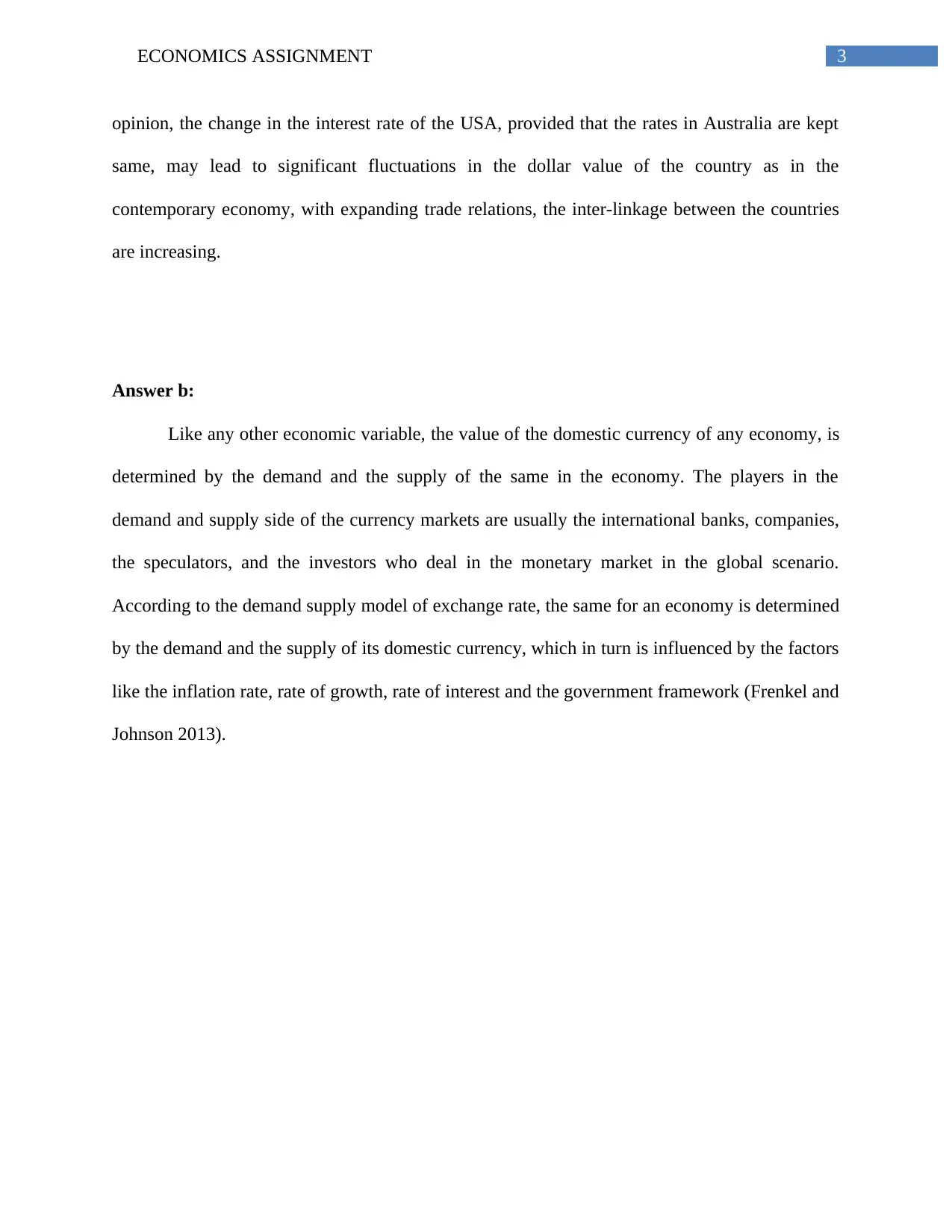
3ECONOMICS ASSIGNMENT
opinion, the change in the interest rate of the USA, provided that the rates in Australia are kept
same, may lead to significant fluctuations in the dollar value of the country as in the
contemporary economy, with expanding trade relations, the inter-linkage between the countries
are increasing.
Answer b:
Like any other economic variable, the value of the domestic currency of any economy, is
determined by the demand and the supply of the same in the economy. The players in the
demand and supply side of the currency markets are usually the international banks, companies,
the speculators, and the investors who deal in the monetary market in the global scenario.
According to the demand supply model of exchange rate, the same for an economy is determined
by the demand and the supply of its domestic currency, which in turn is influenced by the factors
like the inflation rate, rate of growth, rate of interest and the government framework (Frenkel and
Johnson 2013).
opinion, the change in the interest rate of the USA, provided that the rates in Australia are kept
same, may lead to significant fluctuations in the dollar value of the country as in the
contemporary economy, with expanding trade relations, the inter-linkage between the countries
are increasing.
Answer b:
Like any other economic variable, the value of the domestic currency of any economy, is
determined by the demand and the supply of the same in the economy. The players in the
demand and supply side of the currency markets are usually the international banks, companies,
the speculators, and the investors who deal in the monetary market in the global scenario.
According to the demand supply model of exchange rate, the same for an economy is determined
by the demand and the supply of its domestic currency, which in turn is influenced by the factors
like the inflation rate, rate of growth, rate of interest and the government framework (Frenkel and
Johnson 2013).
Paraphrase This Document
Need a fresh take? Get an instant paraphrase of this document with our AI Paraphraser
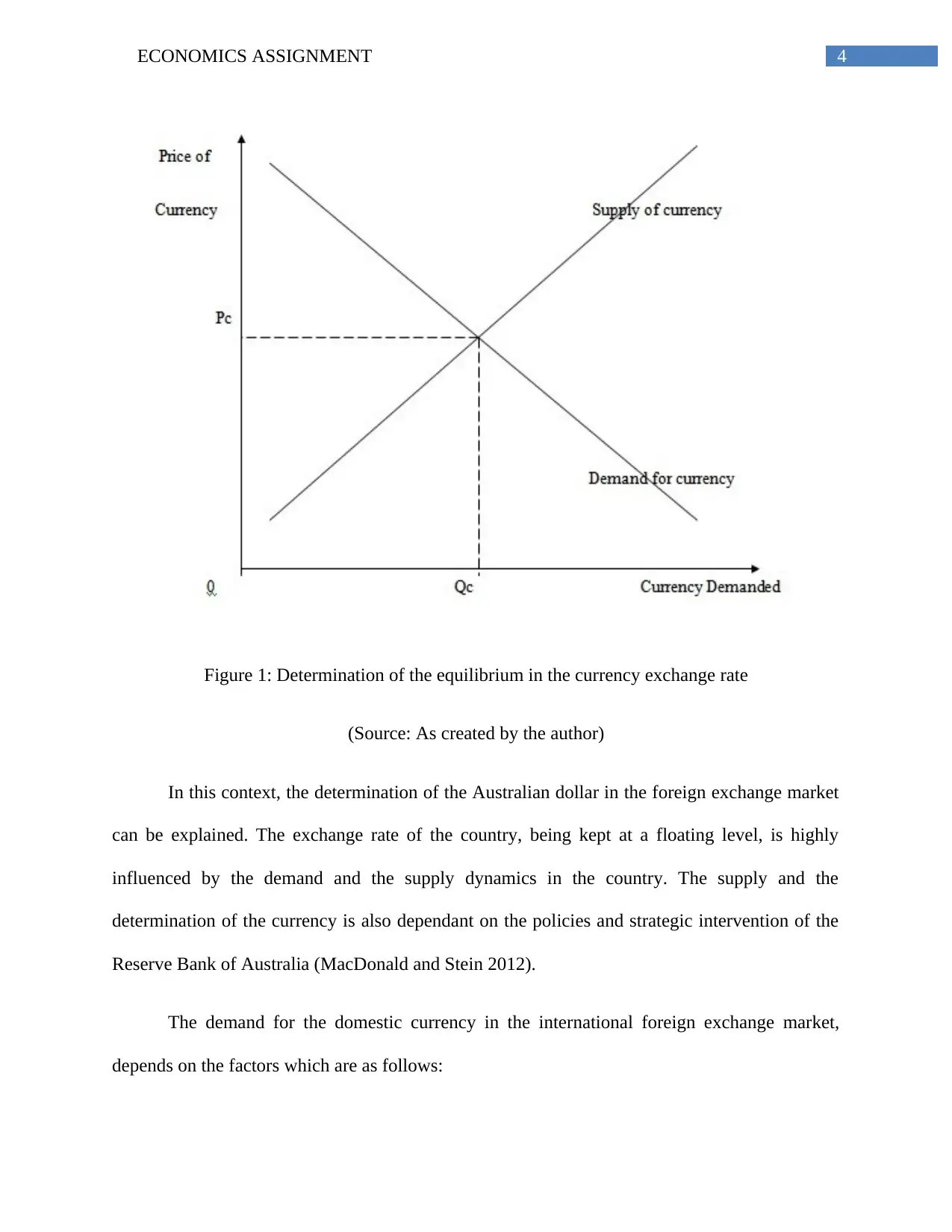
4ECONOMICS ASSIGNMENT
Figure 1: Determination of the equilibrium in the currency exchange rate
(Source: As created by the author)
In this context, the determination of the Australian dollar in the foreign exchange market
can be explained. The exchange rate of the country, being kept at a floating level, is highly
influenced by the demand and the supply dynamics in the country. The supply and the
determination of the currency is also dependant on the policies and strategic intervention of the
Reserve Bank of Australia (MacDonald and Stein 2012).
The demand for the domestic currency in the international foreign exchange market,
depends on the factors which are as follows:
Figure 1: Determination of the equilibrium in the currency exchange rate
(Source: As created by the author)
In this context, the determination of the Australian dollar in the foreign exchange market
can be explained. The exchange rate of the country, being kept at a floating level, is highly
influenced by the demand and the supply dynamics in the country. The supply and the
determination of the currency is also dependant on the policies and strategic intervention of the
Reserve Bank of Australia (MacDonald and Stein 2012).
The demand for the domestic currency in the international foreign exchange market,
depends on the factors which are as follows:
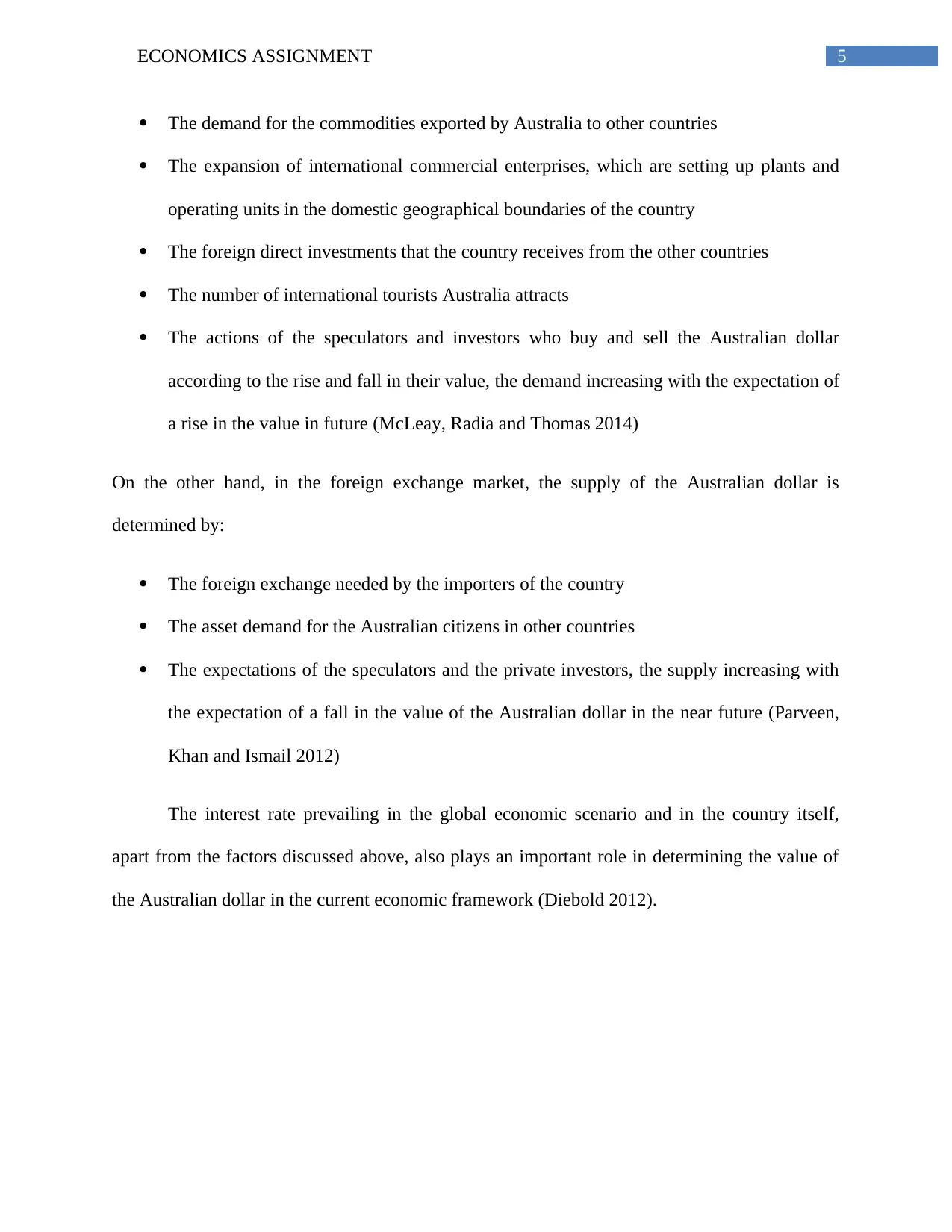
5ECONOMICS ASSIGNMENT
The demand for the commodities exported by Australia to other countries
The expansion of international commercial enterprises, which are setting up plants and
operating units in the domestic geographical boundaries of the country
The foreign direct investments that the country receives from the other countries
The number of international tourists Australia attracts
The actions of the speculators and investors who buy and sell the Australian dollar
according to the rise and fall in their value, the demand increasing with the expectation of
a rise in the value in future (McLeay, Radia and Thomas 2014)
On the other hand, in the foreign exchange market, the supply of the Australian dollar is
determined by:
The foreign exchange needed by the importers of the country
The asset demand for the Australian citizens in other countries
The expectations of the speculators and the private investors, the supply increasing with
the expectation of a fall in the value of the Australian dollar in the near future (Parveen,
Khan and Ismail 2012)
The interest rate prevailing in the global economic scenario and in the country itself,
apart from the factors discussed above, also plays an important role in determining the value of
the Australian dollar in the current economic framework (Diebold 2012).
The demand for the commodities exported by Australia to other countries
The expansion of international commercial enterprises, which are setting up plants and
operating units in the domestic geographical boundaries of the country
The foreign direct investments that the country receives from the other countries
The number of international tourists Australia attracts
The actions of the speculators and investors who buy and sell the Australian dollar
according to the rise and fall in their value, the demand increasing with the expectation of
a rise in the value in future (McLeay, Radia and Thomas 2014)
On the other hand, in the foreign exchange market, the supply of the Australian dollar is
determined by:
The foreign exchange needed by the importers of the country
The asset demand for the Australian citizens in other countries
The expectations of the speculators and the private investors, the supply increasing with
the expectation of a fall in the value of the Australian dollar in the near future (Parveen,
Khan and Ismail 2012)
The interest rate prevailing in the global economic scenario and in the country itself,
apart from the factors discussed above, also plays an important role in determining the value of
the Australian dollar in the current economic framework (Diebold 2012).
⊘ This is a preview!⊘
Do you want full access?
Subscribe today to unlock all pages.

Trusted by 1+ million students worldwide
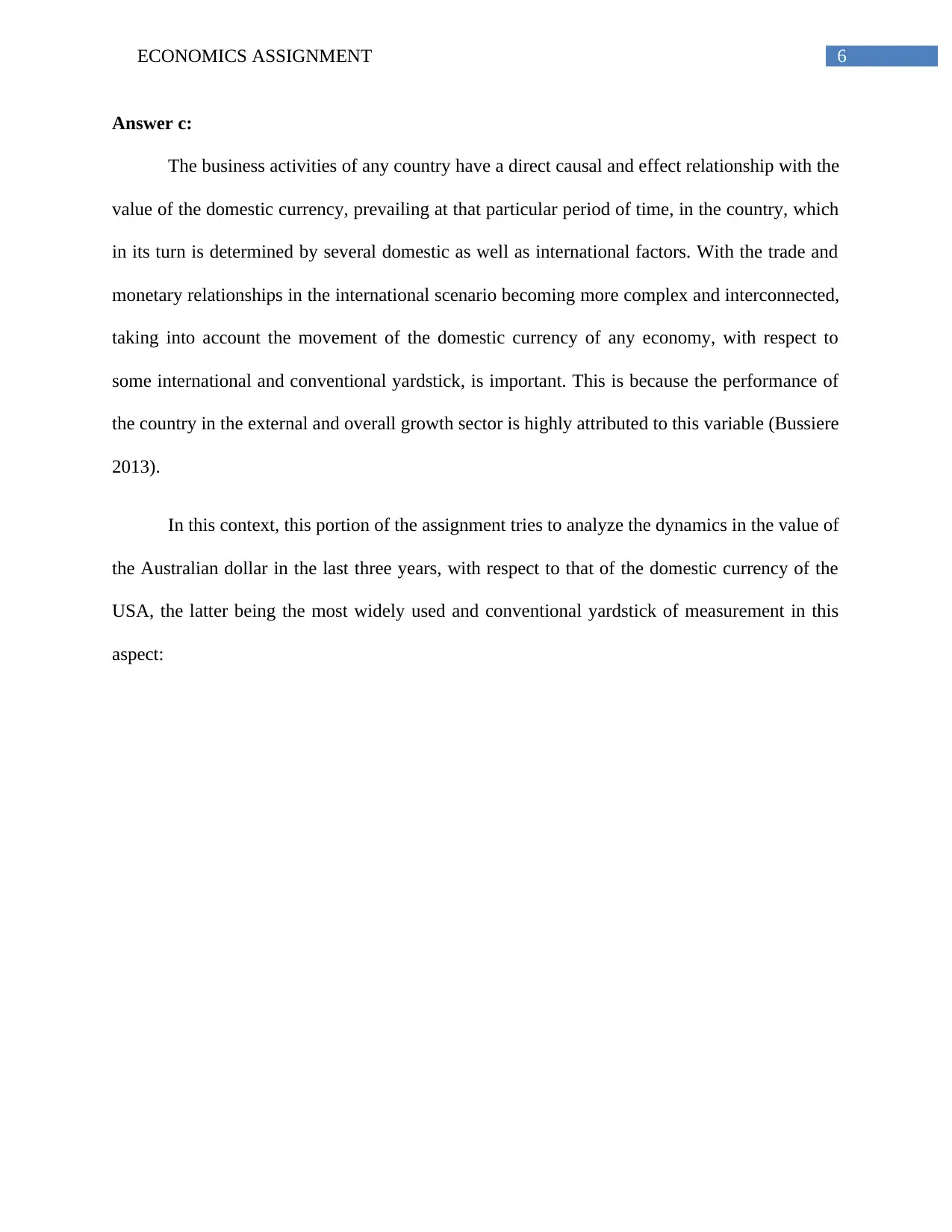
6ECONOMICS ASSIGNMENT
Answer c:
The business activities of any country have a direct causal and effect relationship with the
value of the domestic currency, prevailing at that particular period of time, in the country, which
in its turn is determined by several domestic as well as international factors. With the trade and
monetary relationships in the international scenario becoming more complex and interconnected,
taking into account the movement of the domestic currency of any economy, with respect to
some international and conventional yardstick, is important. This is because the performance of
the country in the external and overall growth sector is highly attributed to this variable (Bussiere
2013).
In this context, this portion of the assignment tries to analyze the dynamics in the value of
the Australian dollar in the last three years, with respect to that of the domestic currency of the
USA, the latter being the most widely used and conventional yardstick of measurement in this
aspect:
Answer c:
The business activities of any country have a direct causal and effect relationship with the
value of the domestic currency, prevailing at that particular period of time, in the country, which
in its turn is determined by several domestic as well as international factors. With the trade and
monetary relationships in the international scenario becoming more complex and interconnected,
taking into account the movement of the domestic currency of any economy, with respect to
some international and conventional yardstick, is important. This is because the performance of
the country in the external and overall growth sector is highly attributed to this variable (Bussiere
2013).
In this context, this portion of the assignment tries to analyze the dynamics in the value of
the Australian dollar in the last three years, with respect to that of the domestic currency of the
USA, the latter being the most widely used and conventional yardstick of measurement in this
aspect:
Paraphrase This Document
Need a fresh take? Get an instant paraphrase of this document with our AI Paraphraser
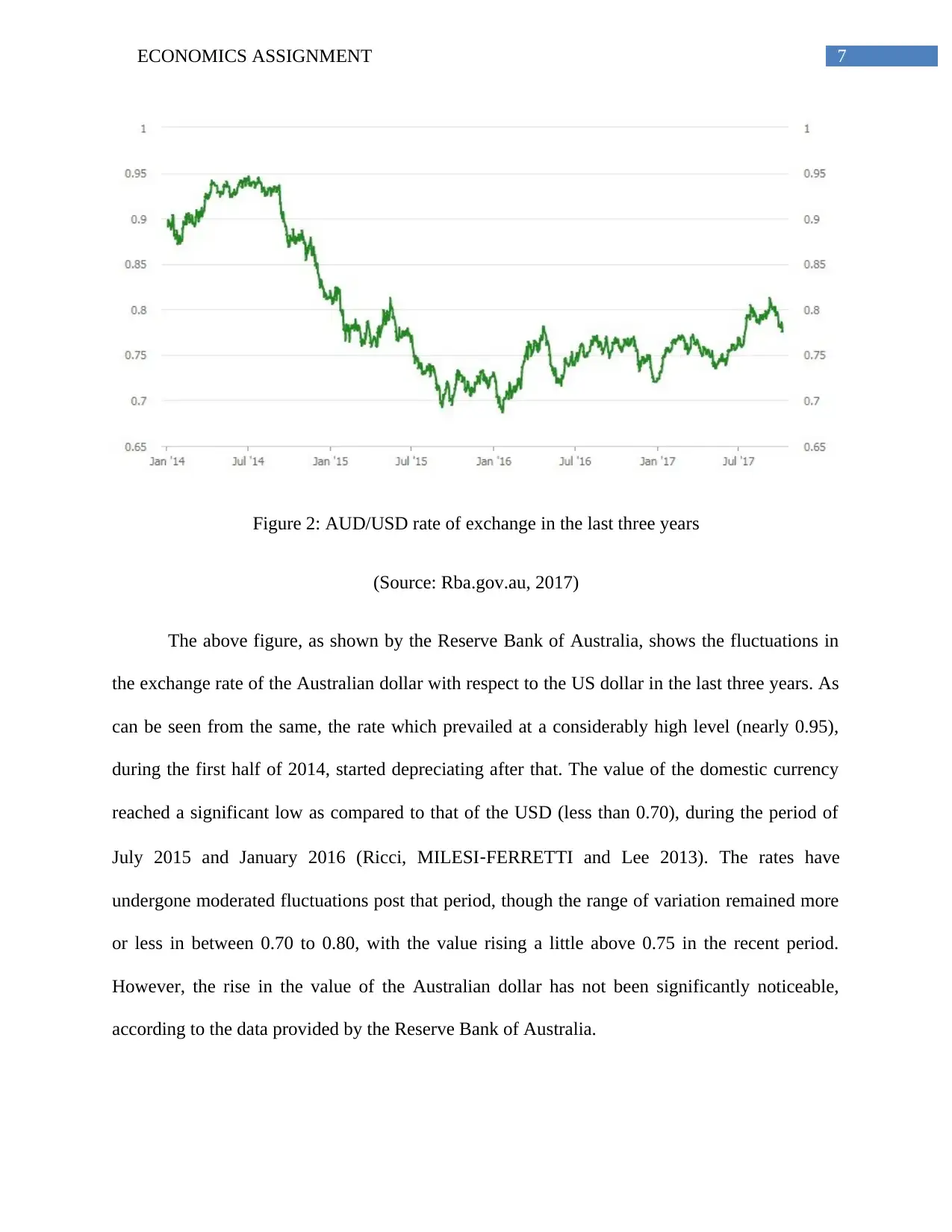
7ECONOMICS ASSIGNMENT
Figure 2: AUD/USD rate of exchange in the last three years
(Source: Rba.gov.au, 2017)
The above figure, as shown by the Reserve Bank of Australia, shows the fluctuations in
the exchange rate of the Australian dollar with respect to the US dollar in the last three years. As
can be seen from the same, the rate which prevailed at a considerably high level (nearly 0.95),
during the first half of 2014, started depreciating after that. The value of the domestic currency
reached a significant low as compared to that of the USD (less than 0.70), during the period of
July 2015 and January 2016 (Ricci, MILESI‐FERRETTI and Lee 2013). The rates have
undergone moderated fluctuations post that period, though the range of variation remained more
or less in between 0.70 to 0.80, with the value rising a little above 0.75 in the recent period.
However, the rise in the value of the Australian dollar has not been significantly noticeable,
according to the data provided by the Reserve Bank of Australia.
Figure 2: AUD/USD rate of exchange in the last three years
(Source: Rba.gov.au, 2017)
The above figure, as shown by the Reserve Bank of Australia, shows the fluctuations in
the exchange rate of the Australian dollar with respect to the US dollar in the last three years. As
can be seen from the same, the rate which prevailed at a considerably high level (nearly 0.95),
during the first half of 2014, started depreciating after that. The value of the domestic currency
reached a significant low as compared to that of the USD (less than 0.70), during the period of
July 2015 and January 2016 (Ricci, MILESI‐FERRETTI and Lee 2013). The rates have
undergone moderated fluctuations post that period, though the range of variation remained more
or less in between 0.70 to 0.80, with the value rising a little above 0.75 in the recent period.
However, the rise in the value of the Australian dollar has not been significantly noticeable,
according to the data provided by the Reserve Bank of Australia.
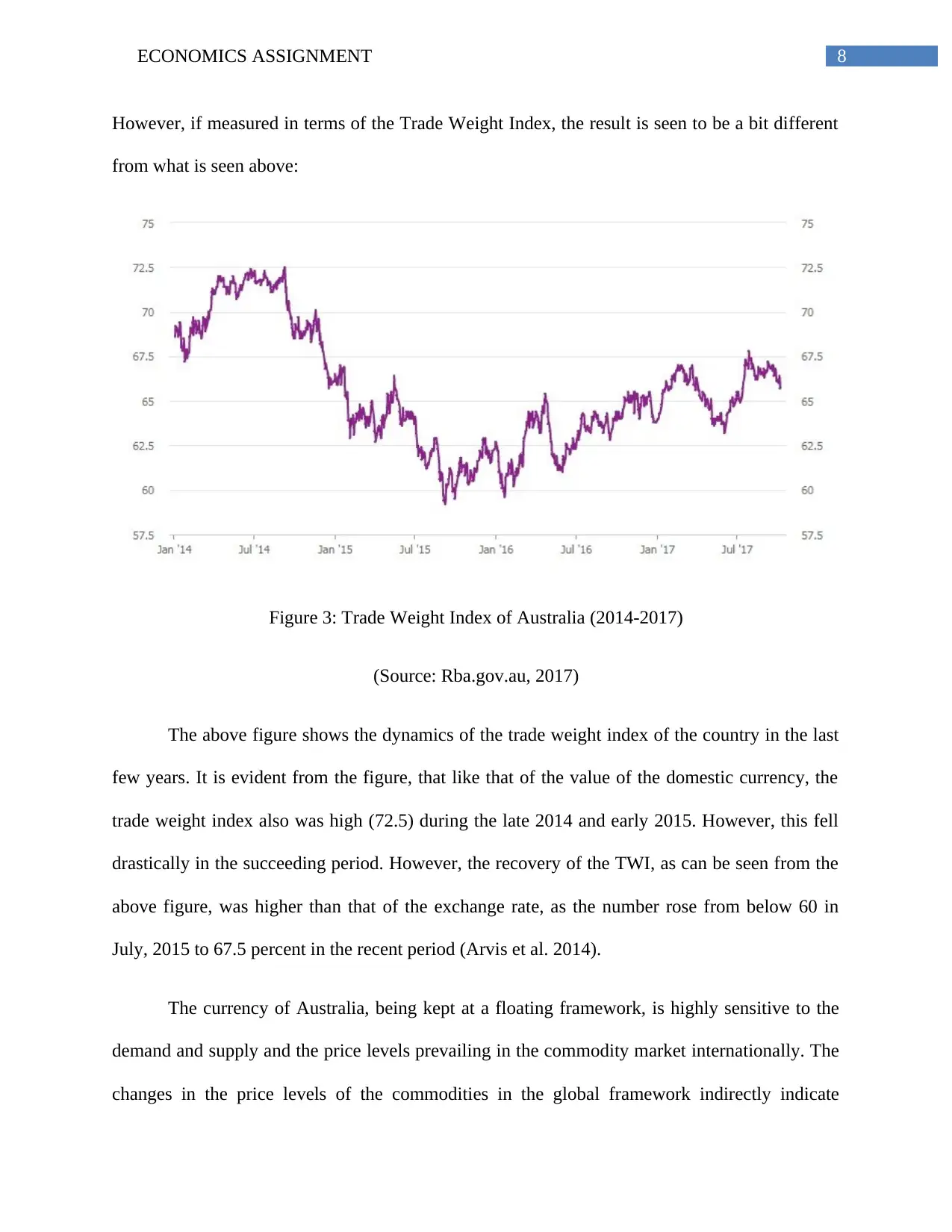
8ECONOMICS ASSIGNMENT
However, if measured in terms of the Trade Weight Index, the result is seen to be a bit different
from what is seen above:
Figure 3: Trade Weight Index of Australia (2014-2017)
(Source: Rba.gov.au, 2017)
The above figure shows the dynamics of the trade weight index of the country in the last
few years. It is evident from the figure, that like that of the value of the domestic currency, the
trade weight index also was high (72.5) during the late 2014 and early 2015. However, this fell
drastically in the succeeding period. However, the recovery of the TWI, as can be seen from the
above figure, was higher than that of the exchange rate, as the number rose from below 60 in
July, 2015 to 67.5 percent in the recent period (Arvis et al. 2014).
The currency of Australia, being kept at a floating framework, is highly sensitive to the
demand and supply and the price levels prevailing in the commodity market internationally. The
changes in the price levels of the commodities in the global framework indirectly indicate
However, if measured in terms of the Trade Weight Index, the result is seen to be a bit different
from what is seen above:
Figure 3: Trade Weight Index of Australia (2014-2017)
(Source: Rba.gov.au, 2017)
The above figure shows the dynamics of the trade weight index of the country in the last
few years. It is evident from the figure, that like that of the value of the domestic currency, the
trade weight index also was high (72.5) during the late 2014 and early 2015. However, this fell
drastically in the succeeding period. However, the recovery of the TWI, as can be seen from the
above figure, was higher than that of the exchange rate, as the number rose from below 60 in
July, 2015 to 67.5 percent in the recent period (Arvis et al. 2014).
The currency of Australia, being kept at a floating framework, is highly sensitive to the
demand and supply and the price levels prevailing in the commodity market internationally. The
changes in the price levels of the commodities in the global framework indirectly indicate
⊘ This is a preview!⊘
Do you want full access?
Subscribe today to unlock all pages.

Trusted by 1+ million students worldwide
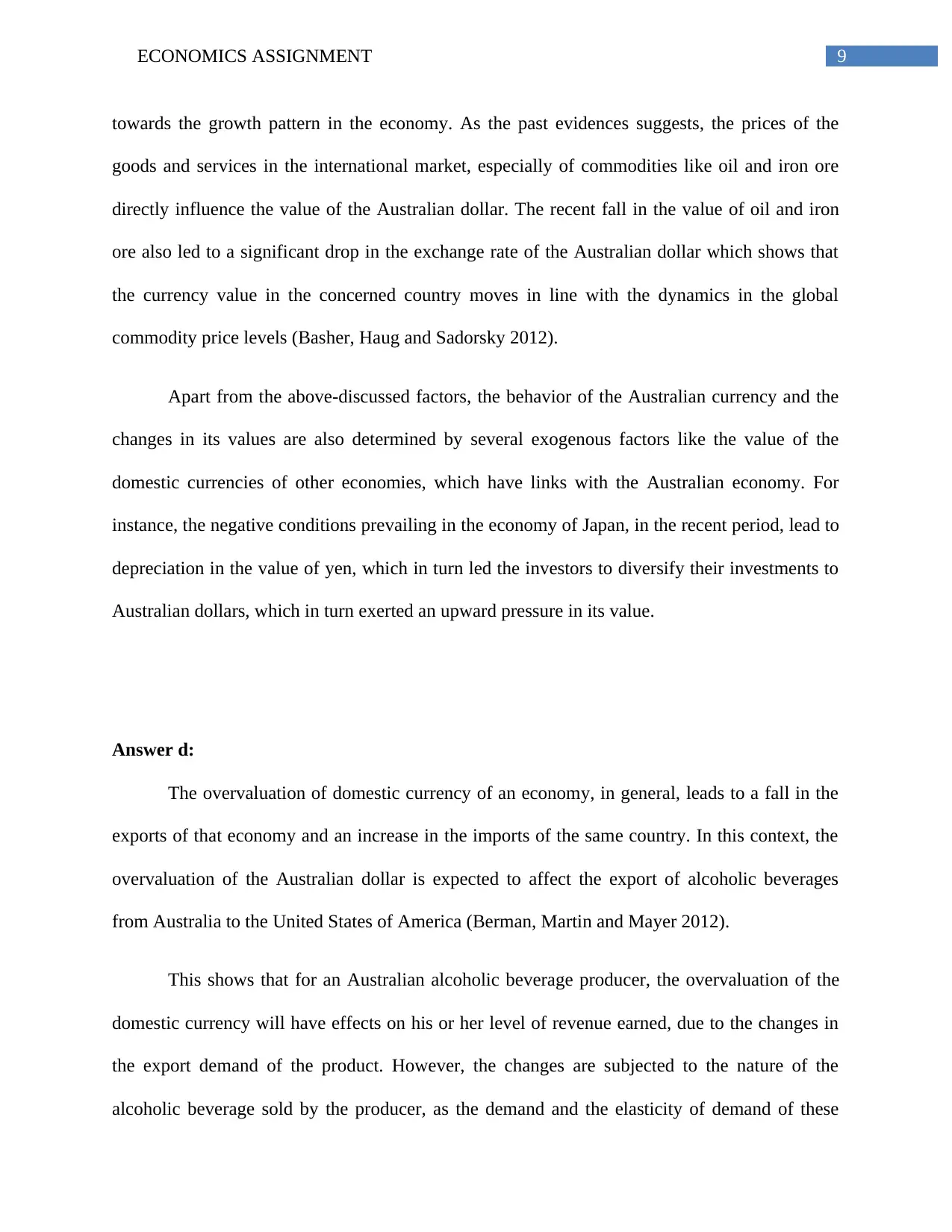
9ECONOMICS ASSIGNMENT
towards the growth pattern in the economy. As the past evidences suggests, the prices of the
goods and services in the international market, especially of commodities like oil and iron ore
directly influence the value of the Australian dollar. The recent fall in the value of oil and iron
ore also led to a significant drop in the exchange rate of the Australian dollar which shows that
the currency value in the concerned country moves in line with the dynamics in the global
commodity price levels (Basher, Haug and Sadorsky 2012).
Apart from the above-discussed factors, the behavior of the Australian currency and the
changes in its values are also determined by several exogenous factors like the value of the
domestic currencies of other economies, which have links with the Australian economy. For
instance, the negative conditions prevailing in the economy of Japan, in the recent period, lead to
depreciation in the value of yen, which in turn led the investors to diversify their investments to
Australian dollars, which in turn exerted an upward pressure in its value.
Answer d:
The overvaluation of domestic currency of an economy, in general, leads to a fall in the
exports of that economy and an increase in the imports of the same country. In this context, the
overvaluation of the Australian dollar is expected to affect the export of alcoholic beverages
from Australia to the United States of America (Berman, Martin and Mayer 2012).
This shows that for an Australian alcoholic beverage producer, the overvaluation of the
domestic currency will have effects on his or her level of revenue earned, due to the changes in
the export demand of the product. However, the changes are subjected to the nature of the
alcoholic beverage sold by the producer, as the demand and the elasticity of demand of these
towards the growth pattern in the economy. As the past evidences suggests, the prices of the
goods and services in the international market, especially of commodities like oil and iron ore
directly influence the value of the Australian dollar. The recent fall in the value of oil and iron
ore also led to a significant drop in the exchange rate of the Australian dollar which shows that
the currency value in the concerned country moves in line with the dynamics in the global
commodity price levels (Basher, Haug and Sadorsky 2012).
Apart from the above-discussed factors, the behavior of the Australian currency and the
changes in its values are also determined by several exogenous factors like the value of the
domestic currencies of other economies, which have links with the Australian economy. For
instance, the negative conditions prevailing in the economy of Japan, in the recent period, lead to
depreciation in the value of yen, which in turn led the investors to diversify their investments to
Australian dollars, which in turn exerted an upward pressure in its value.
Answer d:
The overvaluation of domestic currency of an economy, in general, leads to a fall in the
exports of that economy and an increase in the imports of the same country. In this context, the
overvaluation of the Australian dollar is expected to affect the export of alcoholic beverages
from Australia to the United States of America (Berman, Martin and Mayer 2012).
This shows that for an Australian alcoholic beverage producer, the overvaluation of the
domestic currency will have effects on his or her level of revenue earned, due to the changes in
the export demand of the product. However, the changes are subjected to the nature of the
alcoholic beverage sold by the producer, as the demand and the elasticity of demand of these
Paraphrase This Document
Need a fresh take? Get an instant paraphrase of this document with our AI Paraphraser
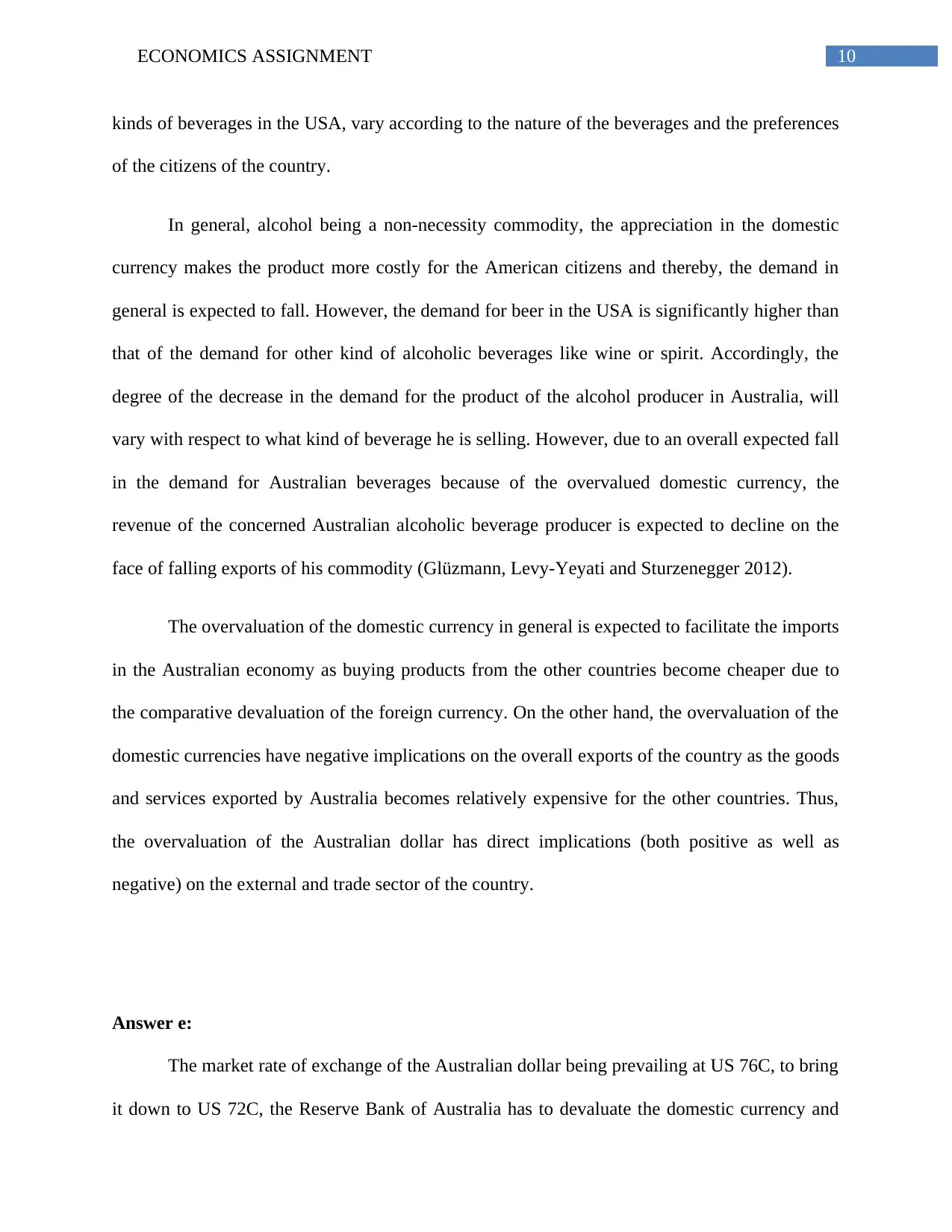
10ECONOMICS ASSIGNMENT
kinds of beverages in the USA, vary according to the nature of the beverages and the preferences
of the citizens of the country.
In general, alcohol being a non-necessity commodity, the appreciation in the domestic
currency makes the product more costly for the American citizens and thereby, the demand in
general is expected to fall. However, the demand for beer in the USA is significantly higher than
that of the demand for other kind of alcoholic beverages like wine or spirit. Accordingly, the
degree of the decrease in the demand for the product of the alcohol producer in Australia, will
vary with respect to what kind of beverage he is selling. However, due to an overall expected fall
in the demand for Australian beverages because of the overvalued domestic currency, the
revenue of the concerned Australian alcoholic beverage producer is expected to decline on the
face of falling exports of his commodity (Glüzmann, Levy-Yeyati and Sturzenegger 2012).
The overvaluation of the domestic currency in general is expected to facilitate the imports
in the Australian economy as buying products from the other countries become cheaper due to
the comparative devaluation of the foreign currency. On the other hand, the overvaluation of the
domestic currencies have negative implications on the overall exports of the country as the goods
and services exported by Australia becomes relatively expensive for the other countries. Thus,
the overvaluation of the Australian dollar has direct implications (both positive as well as
negative) on the external and trade sector of the country.
Answer e:
The market rate of exchange of the Australian dollar being prevailing at US 76C, to bring
it down to US 72C, the Reserve Bank of Australia has to devaluate the domestic currency and
kinds of beverages in the USA, vary according to the nature of the beverages and the preferences
of the citizens of the country.
In general, alcohol being a non-necessity commodity, the appreciation in the domestic
currency makes the product more costly for the American citizens and thereby, the demand in
general is expected to fall. However, the demand for beer in the USA is significantly higher than
that of the demand for other kind of alcoholic beverages like wine or spirit. Accordingly, the
degree of the decrease in the demand for the product of the alcohol producer in Australia, will
vary with respect to what kind of beverage he is selling. However, due to an overall expected fall
in the demand for Australian beverages because of the overvalued domestic currency, the
revenue of the concerned Australian alcoholic beverage producer is expected to decline on the
face of falling exports of his commodity (Glüzmann, Levy-Yeyati and Sturzenegger 2012).
The overvaluation of the domestic currency in general is expected to facilitate the imports
in the Australian economy as buying products from the other countries become cheaper due to
the comparative devaluation of the foreign currency. On the other hand, the overvaluation of the
domestic currencies have negative implications on the overall exports of the country as the goods
and services exported by Australia becomes relatively expensive for the other countries. Thus,
the overvaluation of the Australian dollar has direct implications (both positive as well as
negative) on the external and trade sector of the country.
Answer e:
The market rate of exchange of the Australian dollar being prevailing at US 76C, to bring
it down to US 72C, the Reserve Bank of Australia has to devaluate the domestic currency and
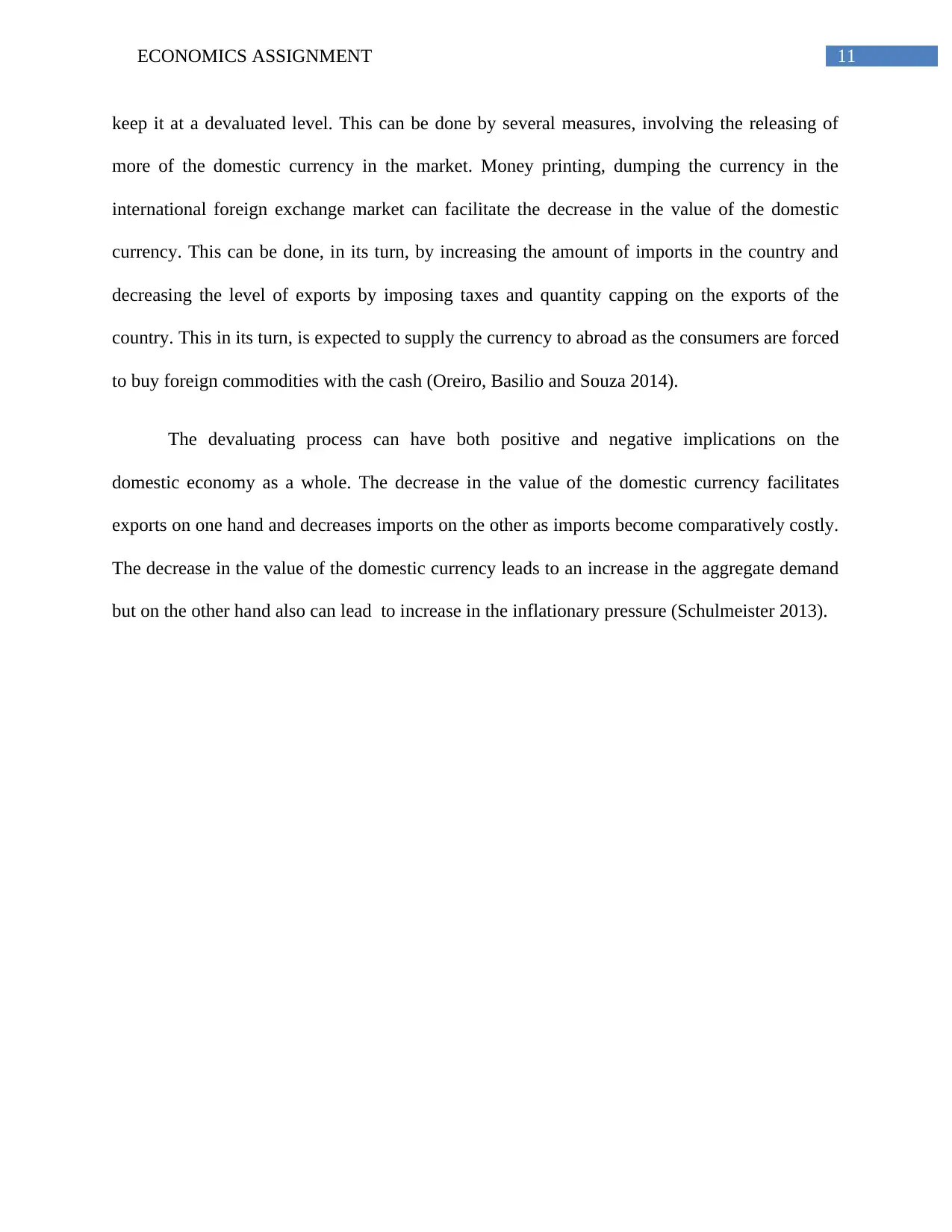
11ECONOMICS ASSIGNMENT
keep it at a devaluated level. This can be done by several measures, involving the releasing of
more of the domestic currency in the market. Money printing, dumping the currency in the
international foreign exchange market can facilitate the decrease in the value of the domestic
currency. This can be done, in its turn, by increasing the amount of imports in the country and
decreasing the level of exports by imposing taxes and quantity capping on the exports of the
country. This in its turn, is expected to supply the currency to abroad as the consumers are forced
to buy foreign commodities with the cash (Oreiro, Basilio and Souza 2014).
The devaluating process can have both positive and negative implications on the
domestic economy as a whole. The decrease in the value of the domestic currency facilitates
exports on one hand and decreases imports on the other as imports become comparatively costly.
The decrease in the value of the domestic currency leads to an increase in the aggregate demand
but on the other hand also can lead to increase in the inflationary pressure (Schulmeister 2013).
keep it at a devaluated level. This can be done by several measures, involving the releasing of
more of the domestic currency in the market. Money printing, dumping the currency in the
international foreign exchange market can facilitate the decrease in the value of the domestic
currency. This can be done, in its turn, by increasing the amount of imports in the country and
decreasing the level of exports by imposing taxes and quantity capping on the exports of the
country. This in its turn, is expected to supply the currency to abroad as the consumers are forced
to buy foreign commodities with the cash (Oreiro, Basilio and Souza 2014).
The devaluating process can have both positive and negative implications on the
domestic economy as a whole. The decrease in the value of the domestic currency facilitates
exports on one hand and decreases imports on the other as imports become comparatively costly.
The decrease in the value of the domestic currency leads to an increase in the aggregate demand
but on the other hand also can lead to increase in the inflationary pressure (Schulmeister 2013).
⊘ This is a preview!⊘
Do you want full access?
Subscribe today to unlock all pages.

Trusted by 1+ million students worldwide
1 out of 14
Related Documents
Your All-in-One AI-Powered Toolkit for Academic Success.
+13062052269
info@desklib.com
Available 24*7 on WhatsApp / Email
![[object Object]](/_next/static/media/star-bottom.7253800d.svg)
Unlock your academic potential
Copyright © 2020–2025 A2Z Services. All Rights Reserved. Developed and managed by ZUCOL.





